The French Press, often revered for its ability to brew a rich and robust cup of coffee, has long been a favorite among coffee enthusiasts around the world. Characterized by its simplicity and the depth of flavor it extracts, this coffee-making method stands out in a world brimming with high-tech brewing gadgets and complex espresso machines.
The historical roots of the French Press can be traced back to the mid-19th century in France, where it began its journey as a rudimentary brewer, involving just a pot and a piece of cloth. However, it was not until the early 20th century that the French Press, as we know it today, began to take shape. Patented by Italian designer Attilio Calimani in 1929, it underwent several modifications before evolving into the modern design that is now familiar in households and cafes globally.
The French Press’s enduring popularity is attributed to its straightforward brewing process which allows for the full extraction of coffee flavors. Unlike other brewing methods that rely on paper filters or intricate mechanisms, the French Press employs a simple plunger-and-filter system. This method ensures that the essential oils and fine coffee particles, which are often filtered out in other methods, contribute to the coffee’s final taste, resulting in a full-bodied and rich brew.
As we delve deeper into the world of the French Press, we will explore not only its historical significance but also the nuances that make it a beloved choice for coffee aficionados. From the intricacies of its brewing technique to the art of selecting the perfect coffee beans, the journey of understanding the French Press is as rich and layered as the coffee it brews.
Understanding the French Press
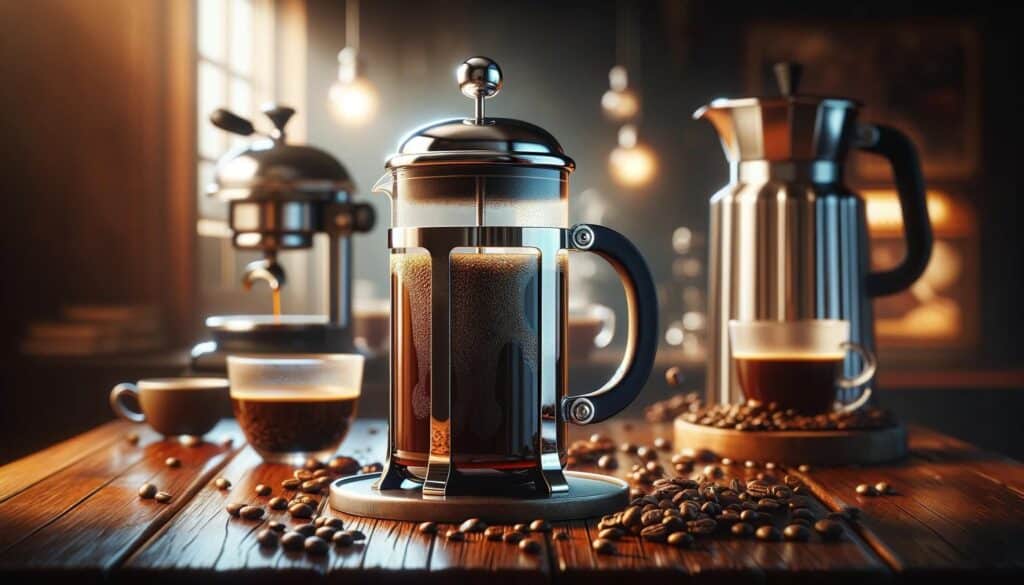
Description of a French Press
The French Press, also known as a press pot, coffee press, or plunger pot, is a timeless and straightforward apparatus used for brewing coffee. At its core, it consists of a cylindrical carafe and a lid equipped with a plunger that moves a filter up and down inside the cylinder. The design of the French Press is elegantly simple, often made of glass, stainless steel, or ceramic, and it embodies both form and function, making it as much a statement piece as it is a coffee maker.
Key Components
- Carafe: The carafe is the central component of the French Press. It is usually cylindrical and made from glass, stainless steel, or ceramic. The material can affect the heat retention and durability of the press. Glass carafes allow you to see the brewing process, while stainless steel and ceramic offer more heat retention and durability.
- Plunger: The plunger is a crucial component that fits snugly into the cylinder of the carafe. It is typically made of metal or plastic and is used to press the coffee grounds down after brewing.
- Filter: Attached to the plunger is a fine mesh filter, which is essential for separating the coffee grounds from the brewed coffee. The filter allows the coffee oils and tiny particles to pass through, contributing to the coffee’s full-bodied flavor. The design of the filter ensures that the coffee grounds are trapped at the bottom of the carafe when the plunger is depressed, allowing the brewed coffee to be poured without any sediment.
- Lid: The lid sits atop the carafe and helps to retain heat during the brewing process. It has an opening that aligns with the spout of the carafe for pouring. When the plunger is pushed down, the lid also helps to seal the top of the carafe, preventing the coffee grounds from escaping into the brew.
The combination of these components in the French Press allows for a unique and interactive brewing process, where the coffee grounds are fully immersed in hot water, extracting their full range of flavors. The simplicity of its design and the direct contact of coffee grounds with water result in a rich, aromatic, and flavorful cup of coffee, distinguishing the French Press from other brewing methods.
The History of the French Press
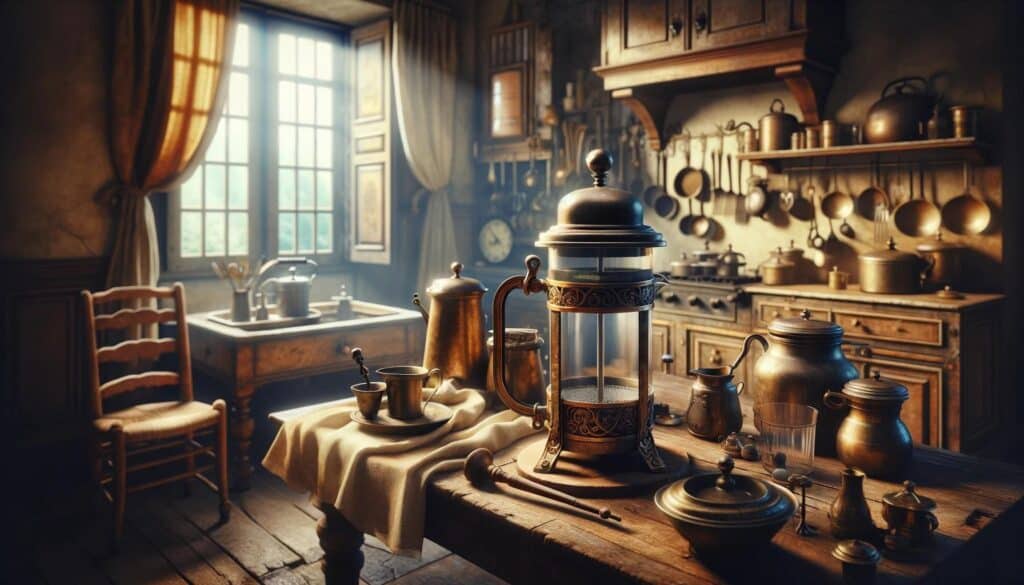
Origins in France
The story of the French Press begins in France during the 19th century. The earliest version was quite rudimentary, involving just a cheesecloth and a rod, used to press grounds at the bottom of a pot of boiling water. The exact origin is a subject of debate, with some stories suggesting that it was accidentally invented by a Frenchman who used a metal screen fitted onto a rod to press his coffee after boiling it.
The transformative moment in the history of the French Press came in 1929 when Italian designer Attilio Calimani patented the first official design. This model closely resembles the modern French Press, with a cylindrical beaker, a lid, and a plunger with a filter. Over the years, this design underwent several refinements, with various patents filed for improvements in the design and functionality of the French Press.
Evolution and Popularity Growth
The evolution of the French Press is marked by a gradual refinement of materials and design. Initially, the carafes were made of glass, which allowed coffee drinkers to see the brewing process. However, issues with durability led to the introduction of more robust materials like stainless steel and ceramic. The plunger and filter system also saw improvements, enhancing the efficiency of separating the coffee grounds from the liquid.
The French Press gained popularity in Europe throughout the mid-20th century, particularly in France and Italy, where coffee culture has always been strong. Its appeal stemmed from its ability to produce a more flavorful and richer cup of coffee compared to other brewing methods at the time. Its simplicity, both in terms of design and the brewing process, made it a favorite among households.
By the late 20th century and into the 21st century, the French Press became popular worldwide, especially among coffee enthusiasts and connoisseurs. It was praised for its ability to highlight the flavor profile of the coffee beans used, offering a more authentic and artisanal coffee experience. This period also saw the French Press becoming a symbol of a sophisticated and mindful approach to coffee, contrasting with the increasing automation in coffee brewing.
Today, the French Press is celebrated not just for its functionality but also as a symbol of a slower, more thoughtful approach to coffee. It encourages a hands-on brewing experience, allowing the drinker to have full control over the strength and flavor of the coffee, making it a lasting favorite in the ever-evolving landscape of coffee culture. Its legacy is a testament to the timeless appeal of simplicity in brewing, and its history reflects the continuous quest for the perfect cup of coffee. As the French Press maintains its place in the modern kitchen, it stands as a bridge between the rich history of coffee brewing and the contemporary pursuit of culinary excellence. This intersection of history and modernity ensures that the French Press remains a beloved method for coffee aficionados around the world, cherished for its ability to unlock the deepest flavors of the coffee bean.
How a French Press Works
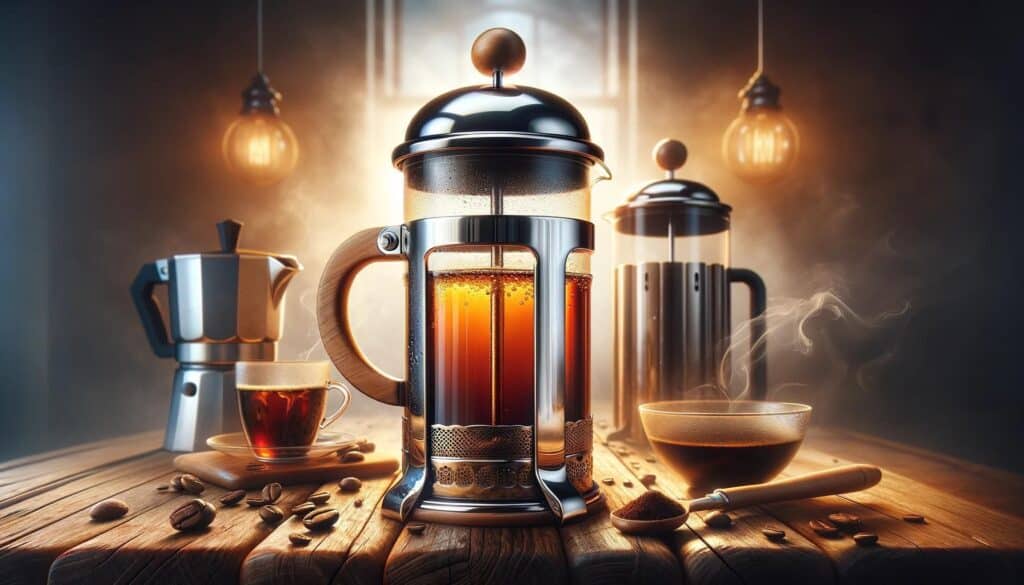
Step-by-step Brewing Process
- Preheat the French Press: Begin by preheating the French Press with hot water. This helps maintain the temperature during the brewing process.
- Measure and Grind the Coffee: Measure the coffee beans and grind them to a coarse consistency. The coarse grind is crucial in a French Press to ensure proper extraction and to prevent the coffee grounds from slipping through the filter.
- Add Coffee to the French Press: Discard the preheating water and add the coarsely ground coffee to the French Press.
- Add Hot Water: Pour hot water — ideally at about 195°F to 205°F (90°C to 96°C) — over the coffee grounds. The hot water initiates the extraction process, drawing out the flavors and oils from the coffee.
- Stir Gently: Give the coffee and water mixture a gentle stir to ensure all the grounds are wet and to aid in the extraction process.
- Place the Lid and Start Timing: Put the lid on the French Press with the plunger pulled all the way up. Start timing the steeping process, which typically lasts about 4 minutes.
- Plunge: After the steeping time, press the plunger down slowly and steadily. This action separates the grounds from the brewed coffee.
- Serve Immediately: Pour the coffee into cups immediately after plunging to prevent it from continuing to sit with the grounds, which can cause over-extraction and bitterness.
The Role of Coarsely Ground Coffee Beans
- Extraction Balance: Coarse grounds are essential in a French Press to achieve a balanced extraction. Fine grounds would over-extract quickly and could pass through the filter, leading to a gritty and bitter brew.
- Plunger Functionality: Coarse grounds ensure the plunger can press down smoothly without too much resistance. Finer grounds can compact at the bottom, making plunging difficult and potentially leading to spills.
Importance of Steeping Time and Water Temperature
- Steeping Time: The typical steeping time for a French Press is around 4 minutes. This duration allows for optimal extraction of flavor and caffeine. Shorter steeping times can lead to under-extraction, producing weak coffee, while longer times can cause over-extraction, resulting in bitterness.
- Water Temperature: The ideal temperature range for brewing in a French Press is between 195°F and 205°F (90°C to 96°C). Water that’s too hot can scald the coffee, leading to bitterness, while water that’s not hot enough might not extract the full range of flavors. Using water within this temperature range ensures the coffee is extracted properly, balancing acidity, sweetness, and bitterness.
The combination of the right grind size, steeping time, and water temperature in a French Press culminates in a rich, flavorful cup of coffee that highlights the unique characteristics of the coffee beans. This method, revered for its simplicity and effectiveness, allows for a full-bodied and aromatic brew, making it a preferred choice for coffee enthusiasts who appreciate the art of manual coffee making. By understanding and mastering these variables, one can consistently create exceptional coffee with a French Press, enjoying a brewing process that is as much a ritual as it is a method of extraction.
Types of French Presses
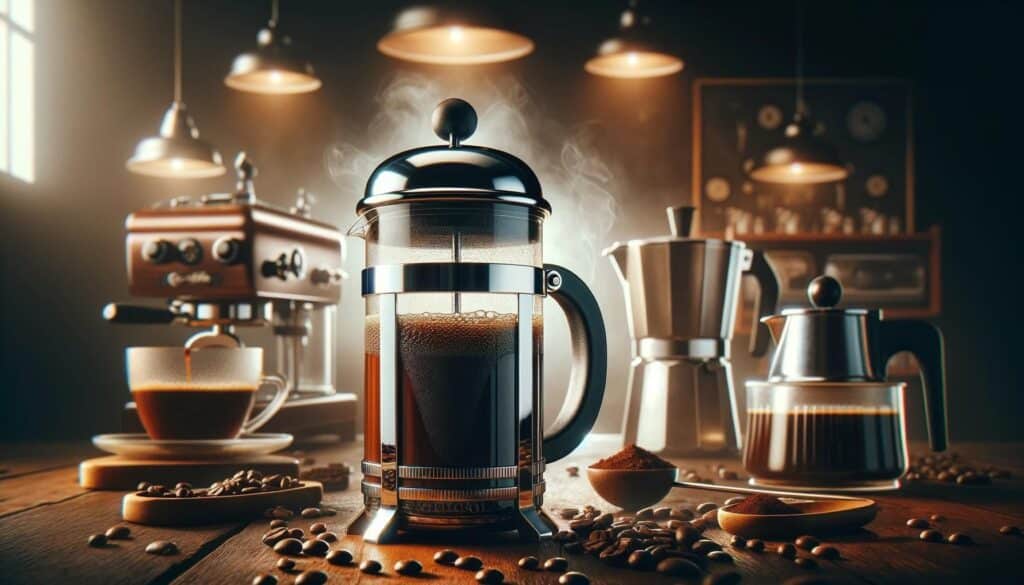
Different Materials
- Glass French Presses:
- Appearance: Glass French Presses are popular for their elegant and classic look. They allow users to view the brewing process, adding a visual element to the coffee-making experience.
- Heat Retention: Glass carafes generally have lower heat retention compared to other materials. However, some come with insulating frames or covers to help retain heat.
- Durability: Glass can be fragile and prone to breaking if dropped or mishandled. Borosilicate glass is often used for its resistance to thermal shock.
- Stainless Steel French Presses:
- Durability: Stainless steel French Presses are known for their robustness and durability. They are ideal for frequent use and environments where breakage is a concern, like outdoor settings or kitchens with hard floors.
- Heat Retention: Excellent heat retention is a significant advantage of stainless steel. It keeps the coffee hot for longer periods, which is beneficial for serving multiple cups over time.
- Appearance: These presses often have a sleek, modern look and can come in various finishes, including brushed and polished.
- Ceramic French Presses:
- Aesthetic Appeal: Ceramic French Presses offer a unique aesthetic with various patterns and colors. They fit well in kitchens where design and decor are important.
- Heat Retention: Similar to stainless steel, ceramic has good heat retention, keeping coffee warm for a reasonable amount of time.
- Durability: While more durable than glass, ceramic can still chip or crack if mishandled, so it requires some care during use and cleaning.
Size Variations
- Small/Individual Size: Typically around 12 to 17 ounces (350 to 500 milliliters), these are perfect for individuals or those who consume only one or two cups of coffee. They are compact and easy to store, making them ideal for small spaces or solo use.
- Medium Size: These usually hold between 18 to 34 ounces (about 500 to 1000 milliliters) and are suitable for small families or gatherings of 2-3 people. This size strikes a balance between being sufficiently large for multiple servings and not too bulky for storage.
- Large Size: Large French Presses can hold from 35 ounces (about 1000 milliliters) upwards, catering to larger families or gatherings. They are perfect for entertaining guests or in office settings where multiple cups of coffee are needed.
The choice of material and size in a French Press can significantly influence the brewing experience and the practical aspects of daily use. Each material offers unique benefits, whether it’s the visual appeal of glass, the durability of stainless steel, or the aesthetic charm of ceramic. Similarly, the size of the French Press should be chosen based on the user’s needs — whether it’s for personal use, family, or entertaining guests. Understanding these variations helps in selecting a French Press that not only meets individual preferences but also enhances the overall coffee-brewing experience.
Benefits of Using a French Press
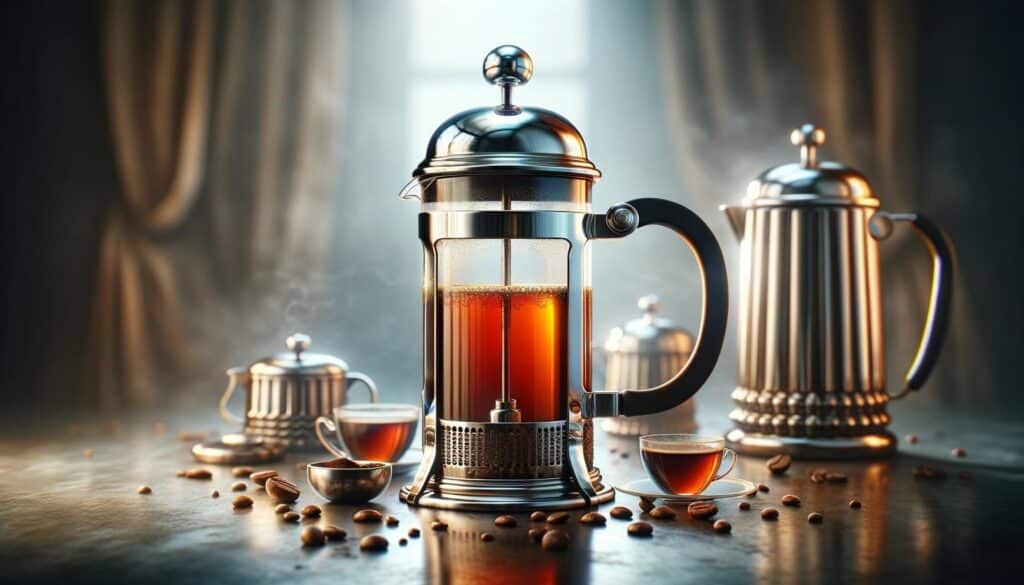
Enhanced Flavor Extraction
- Full Immersion Brewing: The French Press uses a full immersion brewing method, meaning the coffee grounds are completely submerged in water throughout the brewing process. This allows for a thorough extraction of flavors, oils, and aromas from the coffee beans.
- No Paper Filters: Unlike many other brewing methods, the French Press does not use paper filters. Paper filters can absorb some of the oils and finer flavors from the coffee. The metal mesh filter of a French Press allows these oils and fine particles to pass through, resulting in a richer, fuller-bodied cup of coffee.
- Customizable Flavor Profile: The method of brewing in a French Press extracts a diverse range of compounds from the coffee, including some that are only soluble at higher temperatures or longer steeping times. This leads to a complex flavor profile that can be adjusted according to the user’s preference by altering the brewing time and coffee-to-water ratio.
Control over Brewing Strength
- Adjustable Brewing Time: Users have complete control over the brewing time in a French Press. By adjusting the length of time the coffee grounds steep, one can influence the strength and flavor of the coffee. A longer steeping time will result in a stronger brew, while a shorter time yields a lighter cup.
- Customizable Coffee-to-Water Ratio: The French Press allows for easy adjustment of the coffee-to-water ratio, giving users the ability to make their coffee as strong or as weak as they prefer. This flexibility is particularly appealing to those who like to experiment with their coffee.
Eco-Friendly
- No Paper Filters Required: The use of a metal mesh filter eliminates the need for disposable paper filters, making the French Press an environmentally friendly option. It reduces waste and the environmental impact associated with producing and disposing of paper filters.
- Sustainable and Long-Lasting: French Presses, particularly those made from materials like stainless steel or ceramic, are durable and can last for many years with proper care. This longevity reduces the need for frequent replacements, as opposed to some other coffee makers and disposable brewing methods.
- Energy Efficiency: A French Press is a manual brewing method that does not require electricity, unlike electric coffee machines. This aspect makes it more sustainable and energy-efficient, as well as portable and convenient for use in various settings, including outdoor and off-grid environments.
The French Press offers a unique combination of benefits that appeal to both coffee aficionados and environmentally conscious consumers. Its ability to extract a full spectrum of flavors, coupled with the user’s control over the brewing strength and the eco-friendly nature of the device, makes it a popular choice for a premium, sustainable coffee experience. These advantages highlight why the French Press has remained a beloved brewing method for decades, appealing to those who appreciate both the art and the impact of their coffee brewing practices.
Common Misconceptions
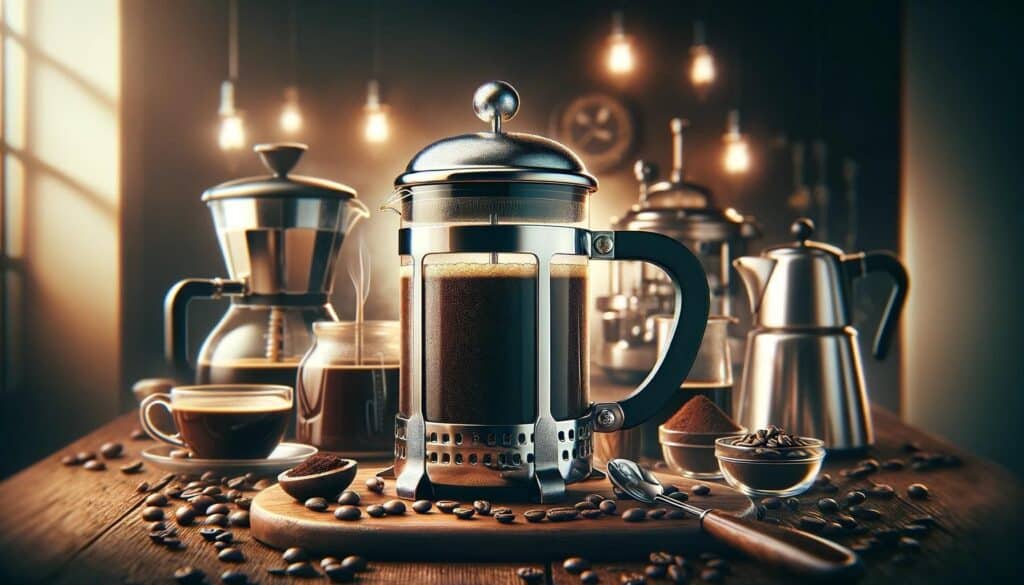
Misconception 1: French Press Coffee is Always Strong and Bitter
- Reality: The strength and bitterness of French Press coffee are largely controllable. It’s a common misconception that French Press coffee is inherently strong and bitter, but this usually results from over-extraction (steeping the coffee for too long) or using a grind that’s too fine. By adjusting the steeping time and using a coarser grind, you can achieve a smoother and more balanced cup.
Misconception 2: French Press is Only for Coffee Experts
- Reality: While the French Press is a favorite among coffee connoisseurs, it’s actually quite beginner-friendly. The process is straightforward and doesn’t require specialized skills or equipment. With basic knowledge of the right coffee-to-water ratio and steeping time, anyone can make a great cup of coffee with a French Press.
Misconception 3: French Press Coffee Contains More Caffeine
- Reality: The caffeine content in French Press coffee is not significantly higher than other brewing methods. It’s the coffee-to-water ratio, the type of coffee beans used, and the brewing time that primarily determine the caffeine level. French Press coffee may taste stronger due to the full extraction of coffee oils and flavors, but this doesn’t necessarily mean higher caffeine content.
Misconception 4: French Presses are Difficult to Clean
- Reality: Cleaning a French Press is relatively simple. Although it may not be as straightforward as tossing out a paper filter, it usually just involves discarding the used grounds, giving it a good rinse, and occasionally taking apart the plunger to clean the filter. Proper maintenance and regular cleaning ensure the longevity and performance of the French Press.
Misconception 5: French Press Coffee is Unhealthy
- Reality: Some believe that French Press coffee is unhealthy because it contains more coffee oils and a small amount of sediment due to the metal filter. However, these oils are natural components of the coffee bean and can actually enhance the flavor profile. The health impact of these oils is still a subject of research, and for most people, they pose no significant health risk. As with any food or beverage, moderation and personal health considerations should guide consumption.
By dispelling these common misconceptions, the French Press can be appreciated for what it truly offers: a versatile, approachable, and satisfying way to brew coffee, capable of producing a rich and full-flavored cup that caters to a wide range of palates and preferences.
Tips for the Perfect Brew

Choosing the Right Coffee Beans
- Freshness Matters: Always opt for fresh coffee beans. The flavor of coffee diminishes over time, so using beans that are freshly roasted will result in a more flavorful cup.
- Bean Origin and Roast Profile: Experiment with beans from different origins and different roast profiles to find your preferred taste. Light to medium roasts typically offer more acidity and complexity, while dark roasts have a fuller body and richer flavor.
- Single-Origin vs. Blends: Single-origin beans come from one location and can offer unique flavors, while blends combine beans from various locations for a more balanced taste. Try both to see which you prefer.
Grinding Tips for the Ideal Consistency
- Coarse Grind: For French Press, a coarse grind is essential. The grind should resemble sea salt in size. Too fine, and you risk over-extraction and sediment in your cup; too coarse, and your coffee may be under-extracted and weak.
- Consistency is Key: Ensure your grind is consistent. A burr grinder is preferred over a blade grinder, as it provides a more uniform grind size.
- Grind Just Before Brewing: Grind your beans just before brewing to ensure maximum freshness. Pre-ground coffee loses its flavor more quickly.
Optimal Water Temperature and Brewing Time
- Water Temperature: The ideal water temperature for a French Press is between 195°F to 205°F (90°C to 96°C). Water that is too hot can burn the coffee, leading to bitterness, while water that’s not hot enough won’t extract the full flavor.
- Heating the Water: If you don’t have a thermometer, bring the water to a boil and then let it stand for about 30 seconds to reach the desired temperature range.
- Brewing Time: A standard brewing time is about 4 minutes. You can adjust this time depending on your taste preference. Shorter brewing will result in a lighter cup, while a longer brewing time will make a stronger brew.
- Experiment and Adjust: Don’t be afraid to experiment with different brewing times and water temperatures. Small adjustments can make a big difference in flavor, so find the combination that works best for your taste.
By following these tips and being mindful of the quality of your beans, the consistency of your grind, and the specifics of your brewing process, you can consistently create a rich and satisfying cup of coffee with your French Press. Remember, the perfect brew is often a matter of personal preference, so feel free to experiment and adjust these guidelines to suit your tastes. The beauty of the French Press is its simplicity and flexibility, allowing you to fine-tune various aspects of the brewing process to craft your ideal cup of coffee. With practice and attention to detail, you’ll be able to enjoy a consistently great coffee experience that is both rewarding and delicious.
Cleaning and Maintenance
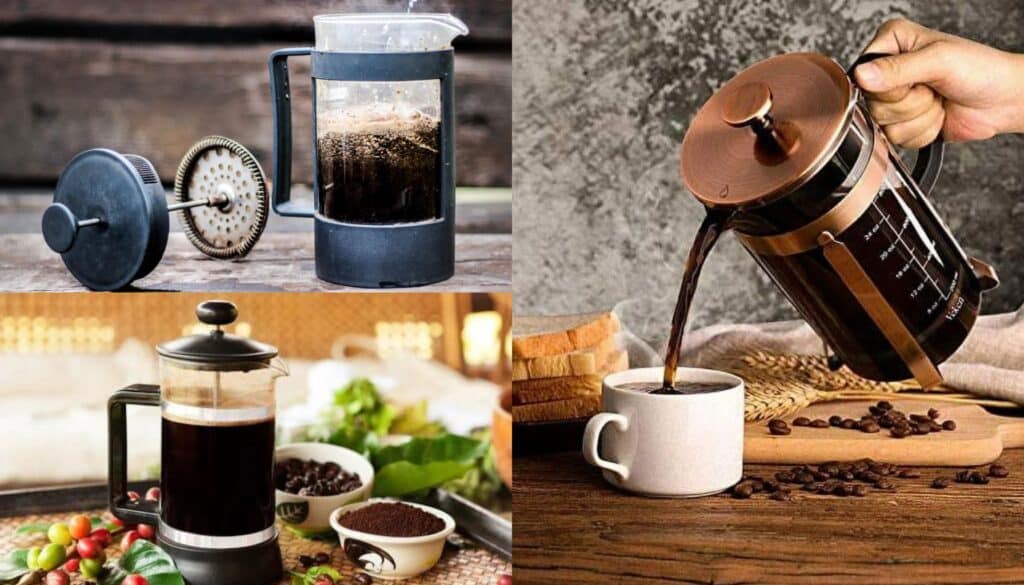
Step-by-Step Cleaning Guide
- Disassemble the French Press: After use, carefully disassemble your French Press. This typically includes removing the plunger unit and separating the plunger, filter screen, and lid.
- Discard Used Coffee Grounds: Empty the used coffee grounds. It’s best to dispose of them in the trash or compost bin, rather than washing them down the sink to avoid clogging your pipes.
- Rinse Each Component: Rinse the carafe and each part of the plunger unit under warm water to remove coffee residue. Pay special attention to the filter screen, as it can trap fine coffee particles.
- Use a Gentle Cleaning Agent: For a thorough clean, use a gentle, non-abrasive soap with warm water. Avoid harsh chemicals that could damage the materials or leave a residue.
- Scrub as Needed: Use a soft sponge or brush to scrub the carafe and parts, especially if there is oil buildup or staining. Be careful with glass carafes to avoid breakage.
- Reassemble After Drying: Once all parts are clean and have been rinsed thoroughly, allow them to dry completely before reassembling your French Press.
Tips for Maintaining Longevity
- Handle with Care: Especially if your French Press has a glass carafe, handle it gently to avoid cracks and breaks.
- Regular Cleaning: Regular cleaning prevents oil and residue buildup, which can affect the taste of your coffee and the longevity of your French Press.
- Check for Wear and Tear: Periodically inspect the plunger and filter for wear and tear. Over time, the mesh filter may become frayed or clogged, which can impact the quality of your brew.
- Avoid Extreme Temperatures: If using a glass French Press, avoid sudden temperature changes, like pouring boiling water into a cold carafe, as this can cause glass to crack.
- Store Properly: Store your French Press in a safe, dry place where it’s not at risk of being knocked over or damaged.
- Replace Parts as Needed: If any part of your French Press breaks or wears out, look into replacement parts before buying a new one. Many manufacturers offer replacement carafes and filter screens.
By following these cleaning and maintenance tips, you can ensure that your French Press remains in good condition, providing you with consistently great coffee for years to come. Regular care not only extends the life of your coffee maker but also ensures that each cup you brew is as delicious as possible.
French Press vs. Other Brewing Methods
Comparison with Drip Coffee
- French Press:
- Pros:
- Full-bodied flavor: Allows essential oils and fine coffee particles to pass through for a richer taste.
- Customizable strength: Control over brewing time and coffee-to-water ratio.
- Eco-friendly: No paper filters needed.
- Cons:
- Sediment: Can leave some sediment in the cup.
- Heat retention: Coffee cools faster unless in an insulated press.
- Manual operation: Requires more hands-on time.
- Pros:
- Drip Coffee:
- Pros:
- Convenience: Mostly automated brewing process.
- Cleaner cup: Paper filter removes most sediment and oils.
- Good for serving multiple people: Often brewed in larger quantities.
- Cons:
- Less control: Limited ability to adjust brewing variables.
- Flavor: May lack the full-bodied richness of French Press coffee.
- Requires filters: Ongoing cost and environmental impact.
- Pros:
Comparison with Espresso
- French Press:
- As above, plus:
- Pros:
- No specialized equipment: More accessible for most users.
- Cons:
- Different flavor profile: Less concentrated than espresso.
- Espresso:
- Pros:
- Intense flavor: Concentrated, rich, and robust.
- Versatility: Base for a variety of coffee drinks.
- Quick brewing time: Faster than French Press.
- Cons:
- Requires equipment: Espresso machines can be expensive.
- Skill needed: Steeper learning curve for perfecting technique.
- Maintenance: Machines require regular cleaning and maintenance.
- Pros:
Comparison with Pour-Over
- French Press:
- As above.
- Pour-Over:
- Pros:
- Control over brewing: Can adjust variables like pouring speed and pattern.
- Clean taste: Paper filter yields a sediment-free cup.
- Aesthetic and ritualistic: Many enjoy the process as part of the experience.
- Cons:
- More equipment: Requires specific pour-over equipment and filters.
- Technique sensitive: Requires practice to perfect.
- Time-consuming: More hands-on and time-intensive than other methods.
- Pros:
Each brewing method has its unique characteristics and suits different preferences and lifestyles. The French Press is ideal for those who appreciate a rich, full-bodied cup and enjoy the process of brewing. Drip coffee is great for convenience and consistency, espresso for intensity and variety, and pour-over for those who enjoy the ritual of brewing and seek a clean, nuanced cup. Your choice depends on what aspects of coffee brewing and consumption you value the most.
Conclusion
The French Press stands out in the world of coffee for its unique ability to create a deeply flavorful and richly textured cup of coffee. Its simple yet effective brewing method fully immerses the coffee grounds in hot water, allowing for the extraction of a wide spectrum of flavors and oils that are often trapped or filtered out by other brewing methods. This results in a cup of coffee that is robust, nuanced, and full-bodied, offering a sensory experience that is both comforting and invigorating.
One of the most appealing aspects of the French Press is its simplicity and accessibility. It does not require specialized equipment or extensive training, making it an excellent choice for both coffee aficionados and novices alike. The process of brewing with a French Press is straightforward yet offers ample room for customization and experimentation. Whether adjusting the grind size, steeping time, or coffee-to-water ratio, users have the opportunity to tailor their brew to their specific taste preferences.
Additionally, the French Press is an eco-friendly option. Its reusable metal filter eliminates the need for disposable paper filters, reducing waste and environmental impact. The manual operation of a French Press also adds a mindful, almost ritualistic quality to the coffee-making process, inviting users to engage more fully with their brew.
In an age where convenience often trumps quality, the French Press invites a slower, more intentional approach to coffee. It’s not just about the end product but also about the experience of creating something with your own hands. The act of brewing coffee becomes a moment of pause in a busy day, a simple pleasure that can be both grounding and gratifying.
For anyone who has not yet tried brewing coffee with a French Press, there is a delightful world of flavor and aroma waiting to be explored. It’s an invitation to slow down, to savor, and to enjoy the process as much as the cup. Whether you are a seasoned coffee lover or just starting to explore the vast landscape of coffee, the French Press is a versatile and rewarding method to add to your brewing repertoire. So, why not give it a try? The perfect cup of coffee, crafted by your own hands, might just become the highlight of your morning.
References and Further Reading
- illycaffè S.p.A. (n.d.). How to use a French Press. illy. Retrieved from https://www.illy.com/en-us/coffee/coffee-preparation/how-to-use-a-french-press
- Good Housekeeping. (n.d.). How to Use a French Press. Retrieved from https://www.goodhousekeeping.com/appliances/coffee-maker-reviews/a31213888/how-to-use-a-french-press/
- Food & Wine. (n.d.). How to Make Coffee Using a French Press. Retrieved from https://www.foodandwine.com/how-to-make-coffee-using-a-french-press-6889978
- Food Network. (n.d.). How to Use a French Press. Retrieved from https://www.foodnetwork.com/how-to/packages/food-network-essentials/how-to-use-a-french-press






